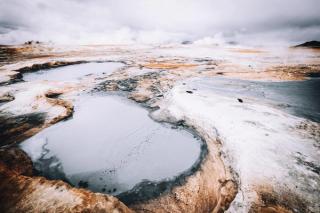
The role of Geology on the road to net zero
- Post Date
- 27 January 2023
- Read Time
- 4 minutes

In this article, the second in a series on geology’s ability to help us address the climate crisis, Paul Gordon discusses how geology can help us to net zero. The first article looked at the opportunities and challenges with underground storage.
Amongst all the uncertainties relating to climate change, there are a few certainties, and one of those is that there is no magic bullet, and I’m not holding my breath while waiting for one. SLR’s Geology team is focussed on providing independent geoscientific assessment of geological resources to support our clients in responsibly sourcing and supplying a de-carbonised economy.
There is a surprising number of ways that the Geosciences can help, across a range of sectors. These include:
- Heat or energy from the earth
- Critical minerals for renewable technologies
- Absorption of CO2 by some rock types
- Deep underground storage of energy and captured carbon
One of the most flexible Geological solutions to the energy transition is geothermal heat or energy. Geothermal energy is well-established in regions with a high subsurface heat flow, e.g., Iceland, parts of Continental Europe and New Zealand. What is less well-known is the remarkable progress that has been made with geothermal heating and cooling using heat pumps. In Ireland and the UK, despite our relatively low subsurface heat flow, we have the potential to provide most of our residential heating needs using geothermal heating. Ireland has broadly more geothermal heat potential than Sweden, while Great Britain is approximately the same, or better, than Sweden. Why am I comparing with Sweden? Well, because it gets roughly 65% of its heating needs from geothermal sources.
According to Statista[1], 87% of UK households use gas to heat their houses. 48% of CO2 emissions in Ireland’s residential sector are from heating[2]. These numbers could be dramatically reduced with geothermal, and that would result in a significant reduction in our reliance on oil and gas. Russia’s invasion of Ukraine has brought our reliance on imported gas into sharp focus and is something that should be addressed as a matter of urgency. Geothermal systems need to be well-designed and they are very effective when you’ve done that.
Geology also provides the raw materials needed for the energy transition. The move away from oil and gas will require a huge increase in the extraction rates of many critical metals. Most of us already know about lithium in batteries, but cobalt is just as important. We need neodymium for the powerful magnets used in wind turbines and solar PV cells need, amongst others, silicon, cadmium, gallium and tellurium. To make all of this electrification work, we’ll need copper, lots and lots of it. An electric car requires 80% more copper than a conventional car. A more dispersed electrical grid will require more power lines. As with oil and gas, security of supply will become more challenging and here in Europe, we are not supplying nearly enough of the raw materials we use now, not to mention what we’re going to need in the immediate future, as the energy transition ramps up. See this article to learn more.
Geological resources can also be used to sequester CO2 in quite a simple way; research has shown that some rock types, when crushed and added to soil, will absorb CO2 from the atmosphere. This has mainly been tried out with basalt, which has the added advantage of carrying a lot of useful minerals for soil health (Hawaii is made of basalt and just think about how lush it is…). There are indications that other rocks, e.g., sandstones from basalt sources, can do the same thing. Key to this is the constituent minerals of the rocks in question, and how they behave in a weathering environment.
We often think of Geological Resources in terms of raw materials that can be extracted, but storage as a resource is increasingly important and will play a key role in reducing CO2 emissions and enabling renewable energy.
There is no magic bullet for the challenges facing us today, but there are plenty of options. Collaboration and communication between sectors and professions will have to increase hugely; Geology and the Geosciences are ready to play their part. Expect to hear from us.
SLR geologists are contributing to decarbonisation in many ways:
Read this article to learn how we are helping to reduce the CO2 emissions associated with cement production.
In this article, you can learn how one of the most important resources on the planet can be protected.
References:
[1] https://www.statista.com/statistics/426988/united-kingdom-uk-heating-methods/
[2] https://www.seai.ie/publications/Heating-and-Cooling-in-Ireland-Today.pdf
Recent posts
-

-

Industrial noise compliance in Alberta: Understanding Directive 038 and Rule 012
by Arthur Kupper
View post -
